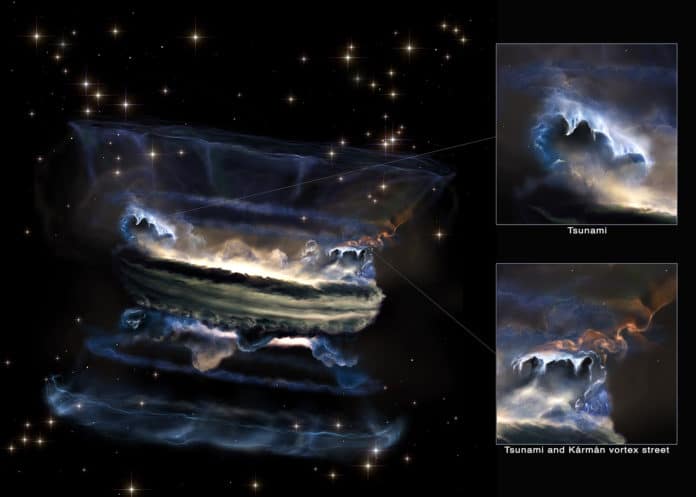Using computer simulations, scientists have shown that how the mysterious environment of supermassive black holes may host the largest tsunami-like structures.
When a black hole with a mass larger than a million Suns feeds material from the surrounding disk at the galaxy center, the system is called an “active galactic nucleus.” Active galactic nuclei may furthermore have relativistic jets at their poles and a thick shroud of material obstructing the view of the central activity.
However, flowing plasma over the disk, sufficiently far that it will not fall into the black hole, shines incredibly bright in X-rays. These x-rays interact with an outflow of gas, generating effects that can be important to tens of light-years from the black hole.
The irradiation of these x-rays could also explain the presence of various populations of denser regions called clouds, which are times hotter than the Sun’s surface. These clouds move at a speed similar to the solar wind.
Now, for the first time, scientists have found that black holes may generate tsunami-like structures. They demonstrated how complicated the clouds within these outflows from the central black hole engine are. Using computer simulations, they have shown that within the distance where the supermassive black hole loses its grip on the surrounding matter, the relatively cool atmosphere of the spinning disk can form waves, similar to the surface of the ocean.
When the waves interact with hot winds, these waves can steepen into spiraling vortex structures that can reach a height of 10 light-years above the disk. By the time tsunami-shaped clouds form, they are no longer influenced by the black hole’s gravity.
The simulations show how X-ray light coming from the plasma near the black hole first inflates pockets of heated gas within the atmosphere of the accretion disk beyond a certain distance from the active galactic nucleus. Heated plasma rises like a balloon, expanding into and disrupting the surrounding cooler gas. It can be scorching — hundreds of thousands to tens of millions of degrees, no matter which unit of measurement one might use.
Rather than a subsea volcanic emission causing tsunamis, these hot pockets of gas in the edges of the accretion disk start the outward engendering aggravation. As the gas particles structure a massive tidal wave-like structure, it hinders the accretion of disk wind, spawning a separate spiral structure pattern known as a Kármán vortex street, with each vortex spanning a light-year in size.
Tim Waters, a postdoctoral researcher at UNLV who is also a guest scientist at Los Alamos National Laboratory, said, “While it all makes sense in hindsight, it was initially quite confusing to observe that thermal instability cannot produce cold gas directly, yet it can take the place of magnetic fields by lifting cold gas into the wind.”
Journal Reference:
- Tim Waters et al. Multiphase AGN Winds from X-Ray-irradiated Disk Atmospheres. DOI: 10.3847/1538-4357/abfbe6
